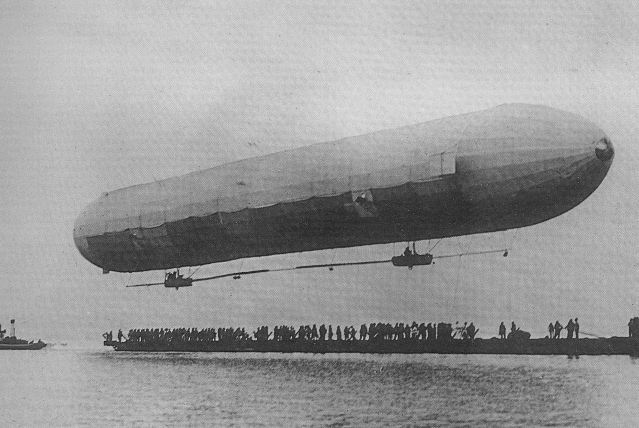The LZ-1 in Flight Over the Bodensee
One hundred sixteen years ago today, at 8:03 in the evening, the LZ-1 slowly floated upward from the surface of the Bodensee and made history. The first successful rigid airship had taken flight, realizing the dream of Count Ferdinand von Zeppelin. For 17 minutes, the Count and four others flew over the lake; until engine trouble and the jamming of the pitch control device forced the airship to land.
The flight was an inauspicious beginning to the dream that has fueled the imagination of men and women ever since. For who hasn’t wished he or she could float in the air just like a cloud and at the same time have the ability to go not only where the wind wishes but to also go where the wind does not wish. For 116 years lighter than air travel has captured our imagination as the airplane never did. The luxury of the Hindenburg has never been equaled by any aircraft before or since.
But today is not only the anniversary of the first flight of the first zeppelin, it is also the anniversary of the realization of the dream of intercontinental flight. In 1919 airplanes first flew across the Atlantic from west to east. However they could not do so in one hop, they had to stop and refuel in the Azores. Or are they made the short flight from Newfoundland to Ireland. Also airplanes did not have enough power to make the east to west flight across the Atlantic against the prevailing winds.
That all changed at 1:42 AM on the morning of 2 July 1919 when the British airship R-34 lifted off from Scotland; her destination being Roosevelt Field, Long Island, New York. On board were 30 persons. The captain was Major George Herbert Scott, the most skillful British airship pilot. The ship was a near copy of a captured German World War I zeppelin and was a magnificent vessel. Her sleek streamlined hull was 645 feet long and was filled with nearly 2,000,000 cubic feet of hydrogen gas.
She was a military vessel and had no creature comforts. In order to serve the crew hot meals on the flight, a metal plate was welded to one of the engine manifolds and the food cooked on it. Off duty crewmen slept in hammocks suspended between the girders. A somewhat perilous endeavor, for if one had the misfortune to roll out of bed he would find himself plunging through the thin fabric covering and on to the ocean far below.
The senior officer onboard was General Maitland, who was the driving force behind Britain’s airship program. He was a popular officer and had devoted his career to innovative flight of all kinds and he was a great believer in the rigid airship. Just before the R-34 lifted off, Maitland wrote in his logbook, “What more wonderful or more delightful adventure could anyone be called upon to undertake?”
Groping its way over the Scottish hillside in the dark and heavy cloud cover, the R-34 headed west and at 5:25 AM, two hours after the sun had risen behind the ship, the R-34 passed the last island off the north Irish coast. The great adventure had begun.
Twelve hours into the flight, when the airship was well out to sea, Aircraftsman Second Class William W Ballantyne revealed himself. He had been cut at the last minute to save weight, but was so eager to make the trip he stowed away. In the afternoon another stowaway was discovered onboard, Wopsie the cat. Ballantyne’s action very nearly jeopardized the voyage. Weight is critical on an airship. His 200 extra pounds deprived the ship from carrying that weight in fuel, which as it turned out nearly caused the voyage to end in failure.
When the airship had just gotten underway, General Maitland described the experience as follows:
When flying at night, possibly on account of the darkness, there is always the feeling of utter loneliness directly one loses sight of the ground. We feel this loneliness very much tonight; possibly owing to the fact that we are bound for a totally unknown destination across the wide Atlantic.
But the necessity of work soon dispelled any feelings of loneliness. The airship required careful flying because of the darkness and the heavy cloud cover, which, when the sun rose, became a heavy fog.
Lunch on board the airship was beef stew, potatoes, chocolate, and water. Not five star, but a hot meal is always welcomed.
In the evening, as the temperatures fell, Major Scott increased the height of the airship to 2000 feet. For a time, the R-34 flew through a heavy cloud bank and the crew found themselves in a dream-like enchanted setting over the ocean. One person recorded it this way, “We feel in a world of our own up here amidst this dazzling array of snow-white clouds. No words can express the wonder, the grandeur, or the loneliness of it all…”
And thus the R-34 flew on into the night, heading for America.
Tomorrow, we continue the adventure. Stay tuned!
Share This!



Must have been a truly unique experience. I’m very much in awe of these pioneers of the flight. Imagine doing something like this for the first time ever. Must have been breathtaking.
Indeed it must’ve been. The rigid airship as we know it today was invented by Count Zeppelin. A person who had no experience of flight save for a balloon ride during the American War Between the States and no knowledge of engineering, being a military officer. Truly amazing.
That says a lot about the power of passion
It very much does, doesn’t it?